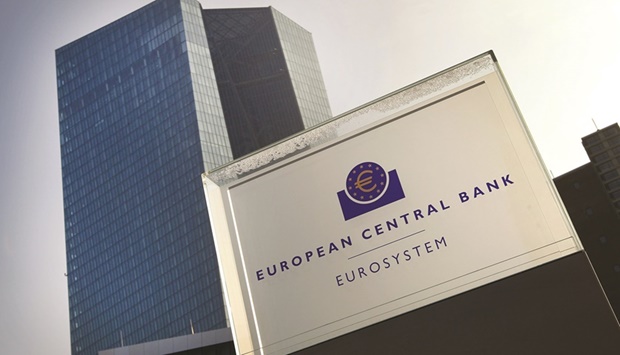The European Central Bank (ECB)’s window for outsized interest-rate increases is closing as a recession looms and borrowing costs approach levels that no longer offer support.
Record inflation and the danger of winter energy shortages are sinking confidence in the euro-zone economy. As the hard data gradually worsen, the hawks who currently steer ECB policy have only a limited opportunity to deliver more big hikes.
That chance could amount to the next two meetings in October and December, with markets already betting the first will deliver a repeat of September’s historic 75 basis-point step. Come the New Year, arguing that the battle with prices trumps growth – the position of many of the world’s central banks right now – will get much harder.
Officials in Washington this week for the International Monetary Fund’s annual meetings got a sense of just how bad things may get, with the lender slashing its forecast for 2023 euro-area growth to just 0.5%. Germany and Italy are both predicted to suffer an annual contraction.
A souring economy risks setting up a clash with the ECB’s dovish cohort, which has stayed largely quiet as quantitative easing was ended, the policy toolbox was revamped and rates were lifted by 125 basis points.
“The ECB needs to act quickly now to thrash down inflation expectations before wage negotiations lead to second-round effects,” said Karsten Junius, chief economist at Bank J Safra Sarasin. “Once recession risks turn into reality and the strains on the economy start to show, it’ll be difficult to push through larger hikes.”
The ECB’s latest projections don’t include a recession in the 19-nation euro area, though Russia’s recent energy-market meddling probably renders the forecasts obsolete, and surveys of purchasing managers have flagged shrinking output since July. Economists increasingly see a downturn as inevitable. ECB President Christine Lagarde says a recession won’t distract from the task of wresting inflation back to the 2% target from 10% last month. She doesn’t see a slump taming prices on its own.
“Our primary objective is price stability and we have to deliver on that. If we were not delivering, it would hurt the economy far more.”
Either way, third-quarter data on gross domestic product aren’t due until October 31 – four days after this month’s decision on rates.
An initial recession call can only come when figures for the final three months of 2022 are published in January.
By then, most policy makers want to see the deposit rate, currently 0.75%, at the so-called neutral level that neither stimulates nor constrains the economy – thought to be somewhere near 2%.
To get there quickly, Latvia’s Martins Kazaks and Lithuania’s Gediminas Simkus are among officials leaning toward doubling the rate to 1.5% this month. Finland’s Olli Rehn and Germany’s Joachim Nagel also back a muscular step.
Dutch central bank chief Klaas Knot said on Monday that at least two more “significant” hikes are needed.
Officials are reluctant to say where rates will peak but for the hawks, speed is key. While rate increases aren’t the driving force behind Europe’s deteriorating economy, they’ll become less palatable as households suffer. The doves are already finding their voice.
Chief Economist Philip Lane is among those urging restraint, saying it’s too early to determine the ECB’s next move. Portuguese central bank chief Mario Centeno cautions that going too far now risks having to backtrack later on.
Italy’s Ignazio Visco may have put it most clearly, referring in rare public comments to a “sudden deterioration in the economic-growth outlook.”
“Excessively rapid and pronounced rate hikes would end up increasing the risk of a recession,” he said in late September.

The headquarters of the European Central Bank in Frankfurt. The ECB’s window for outsized interest-rate increases is closing as a recession looms and borrowing costs approach levels that no longer offer support.


